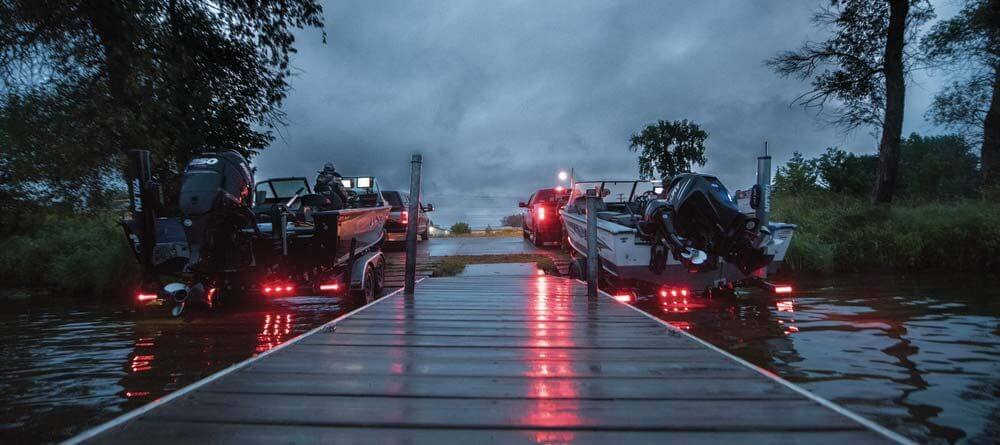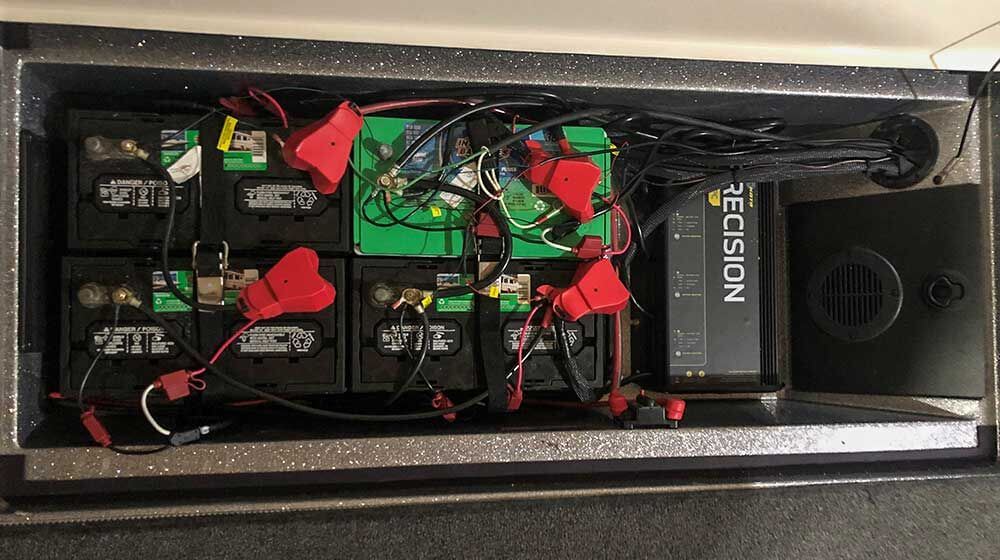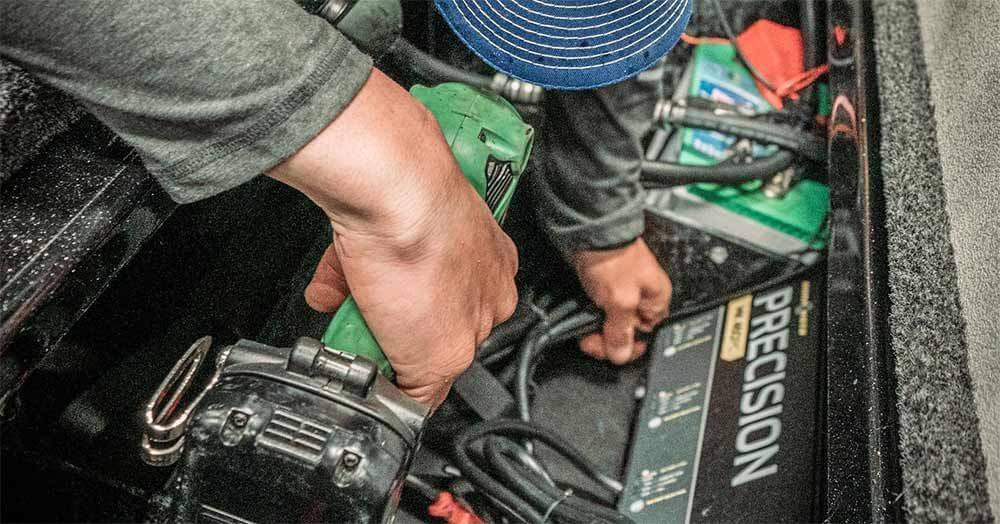The Importance of Marine Battery Maintenance
How to get more life out of your trolling motor and cranking batteries. It starts with proper maintenance and care.

The sun's not quite up over the horizon when it's your turn to launch at the busy boat ramp. All backed in, your rig floats off the trailer, and your buddy holds it steadfast to the dock with the mooring lines. You park and hurry back as there are so many others waiting. Now in the boat, the key gets turned and, and, and... nothing; the only sounds heard are the countless groans from those waiting in line.
Yeah, you just became "that guy"; not only the one with the proverbial monkey wrench thrown into his day's fishing gears but the one delaying all those other anglers now facepalming and shaking their heads.
But you didn't have to be that guy.
How to Extend Marine and Trolling Motor Battery Life

Start a conversation about what deep cycle batteries are best for boats on social media and you'll get 100's of different answers about absorbed glass mat (AGM), gel, flooded lead acid, and lithium. (Don't to know what a deep cycle battery is? Check out this article.) All have their place. All can fail. And they don't have to be old to take a sudden nosedive. It takes nothing more than improper charging, and their lifespan can be shortened tenfold.
"Basically, you have a battery go bad, and you're not going fishing; it's as simple as that," says Jason Przekurat. The Stevens Point, Wisconsin, angler has been promoting the sport of fishing full time since 2007, starting as a guide and tournament angler in 1995 and now focusing on the latter throughout the Midwest, as well giving seminars and appearing in videos.
"The technology of today's battery chargers is amazing, even compared to what it was only five years ago. The speed at which batteries can be charged without damaging them has increased, which allows me to know my boat is 100-percent ready go with just one overnight charging. That's not the way it used to be, however; I don't know how many times I had to head out for a full day on the water with batteries that weren't totally topped off."

Aboard Przekurat's boat is four group-size 31 batteries; three for his Minn Kota bow-mounted trolling motor and one for starting his engine, running his Humminbird electronics, bilge pumps and more. Also onboard is a four-bank Minn Kota On-Board Precision Charger, which keeps his batteries in tip-top shape.
"The Minn Kota Precision is so much more than a battery charger; it's a full-service battery-maintenance device," Przekurat adds.
Right off the get-go, it's internal intelligence senses how much current is going into the system itself, compensating for any low-voltage impute when outlets aren't putting out the 120 volts they're supposed because they're overloaded, or, the unit is hooked up to long extension cords.
Next, each bank of the Precision has a mind of its own, sensing the ambient temperature and creating just the right amount of charge for each battery. And with just a push of a button, you're able to select the type of battery each bank is wired to, as well, giving each one the proper current for its kind and the conditions.
Overcharging and Undercharging Marine Batteries
"Overcharging? Undercharging? Neither are good," says Dan Baston, Product Manager / Lead Engineer at Minn Kota. Over or undercharging your batteries will shorten their overall life. Minn Kota chargers are digitally designed to deliver just the right amount of juice every time you plug in. No more. No less.
"We've met with several of the large battery manufacturers to see what each style and brand needs for long-lasting performance. And we've built each and every one of those needs into our chargers. These are huge features that no other charger manufacturer has compensated for."
With up to 15 amps pumping in, batteries charge quickly, and then the Precision turns off the juice individually as each battery tops off. If a charge is being added to a battery that's fully charged, irreversible damage can occur. And there are many chargers on the market that keep the power on until you unplug it.
The good thing is, all Minn Kota Marine Battery Chargers come with Automatic Multi-Stage Charging where the charger controls the voltage and current your battery gets throughout the charging cycle, ensuring a fast, safe and precise charge. Precision battery chargers also reduce voltage and display a flashing 100% GREEN LED for each bank to indicate the battery is in Maintenance Mode and ready to use.
After 12 hours, the charger automatically turns off and a steady 100% GREEN LED is lit for each bank to indicate the battery is in long term Maintenance Mode and ready to use. The charger will automatically resume charging when the battery voltage drops below 12.6V.
Marine Battery Longevity and Lifespan

Beyond giving a battery a full charge, the most crucial aspect of battery-life longevity is maintenance.
A microprocessor-based design enables Minn Kota chargers to monitor the temperature and state of charge continually, and turn on when needed with just the right amount of juice for each bank. Automatic Multi-Stage Charging controls the voltage, and current your battery gets throughout the charging cycle.
"The On-Board Precision charger has a very dynamic charge curve, implemented with temperature compensation. Overall, other brands build their chargers to work best at 25-degrees Celsius [77-degrees Fahrenheit]; this one, however, adjusts the output for the conditions at hand, ensuring a fast, safe and precise charge," Baston says.
Baston also adds that for battery longevity, especially with lead acid batteries, to get them on the charger within 12 to 24 hours of use. Also, never drain them to the point they are dead as damage will undoubtably occur. Never storing batteries uncharged, as well not allowing them to freeze is a must, as well.
8 Tips for Extending Marine Battery Life
-
Charge after every use and allow the battery to receive a full charge
-
Avoid high voltage fast charging cycles – Stick to recommended voltage requirements and unplug immediately after the charge is complete OR see the next tip.
-
Use a charger with Multi-Stage Charging for a safe and fast charge – As mentioned above, all Minn Kota Marine Battery Chargers come with Automatic Multi-Stage Charging where the charger controls the voltage and current your battery gets throughout the charging cycle, ensuring a fast, safe and precise charge. Precision chargers also reduce voltage and display a flashing 100% GREEN LED for each bank to indicate the battery is in Maintenance Mode and ready to use. A steady 100% GREEN LED is lit for each bank to indicate the battery is in long term Maintenance Mode and ready to use. The charger will automatically resume charging when the battery voltage drops below 12.6V.
-
Avoid storing in very cold or hot temperatures – Bring your batteries inside over winter when your boat is in storage and avoid leaving them in your boat or garage for long periods of time during extremely hot temperatures.
-
All Minn Kota battery chargers have an Automatic Temperature Compensation feature that adjusts for fluctuations in temperature to prevent damaging your battery.
-
-
Battery Equalization (Flooded Lead Acid Batteries only) – Cleans and protects your battery to improve battery life
-
Utilize a charger that has battery equalization that cleans and protects your battery at least once or twice a year. Ideally, once in spring and once before winterization or in fall.
-
The beauty is that Minn Kota Precision onboard chargers do it automatically, every time you plug it in. They also allow you to activate a more rigorous cleaning with a push of a button.
-
Watch this Battery Equalization video for more information
-
-
Ensure proper water levels in flooded lead-acid batteries – Top them off with distilled water
-
Avoid storing uncharged batteries for long periods of time
-
Keep your battery terminals clean - Scrub off any corrosion with a brush and a paste solution of baking soda and water.
Full Charge Ahead!
By following these simple battery maintenance tips, you can extend the life of your batteries by a couple of seasons – resulting in more money in your wallet and more time on the water. You don't have to be that guy with the proverbial monkey wrench thrown into his day's fishing gears and delaying all of the other anglers sitting there shaking their heads.
Just remember it's not usually the battery's fault, rather an inferior charger, and improper maintenance.









